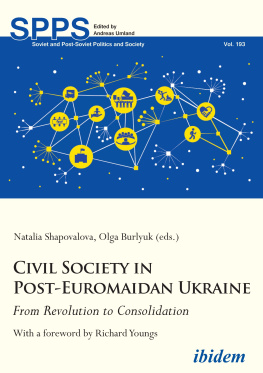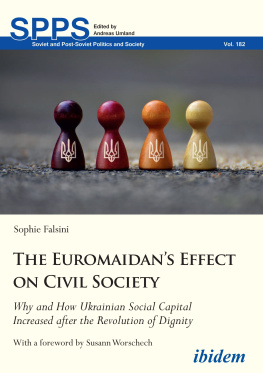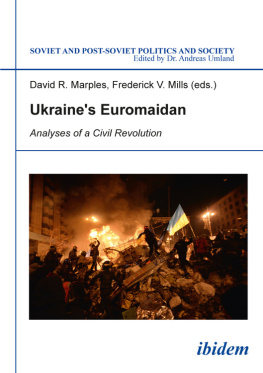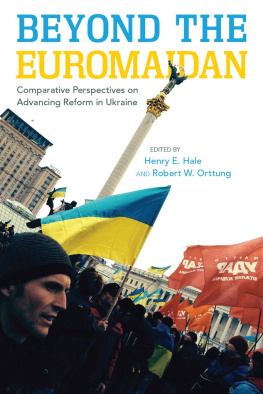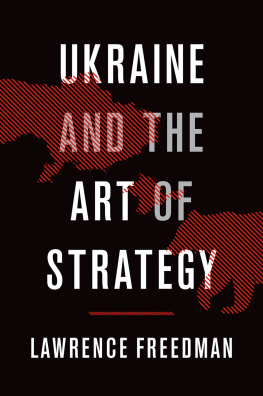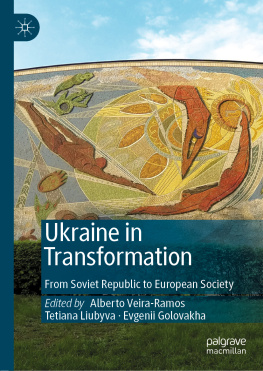Foreword
Richard Youngs
In recent years, civil society around the world has undergone important changes. Innovative forms of activism are emerging and mass protests have occurred in a large number of countries in every region of the world. While much of this surge in activism is based around familiar forms of political contestation and formal NGOs, at least some of it appears to be qualitatively different and even experimental. These developments have prompted a series of academic and policy debates about how significant the changes to global civil society really are; about what is driving the emergence of a transformed activism; and whether the changes are an advance or setback for democratic politics.
Natalia Shapovalova and Olga Burlyuk have compiled a volume that contributes enormously to these debates. There is a clear need for in-depth case studies and this volume delivers quality chapters that address the many different dimensions of the civic activism that has taken shape in Ukraine since the 2014 Euromaidan revolt. The book represents a major addition to work on Ukraine itself, as it represents the first comprehensive assessment of post-Euromaidan civil societyand the conclusions the chapters generate will be of intense value and interest to those studying and engaged in the countrys still-fluctuating reform process. But the volume will have a wider appeal and relevance too, to the extent that it speaks to the more general debates about the ongoing evolution of civil societys very nature and essence across the globe.
Indeed, the volume shows that Ukraine is an especially evocative and significant case for these debates. The country has witnessed the growth of an extremely vibrant civil society that, as the following chapters show, has had real impact. It is a country where civic activism intersects deeply with geopolitics, with the book highlighting the role of conflict in the east of Ukraine in propelling new forms of activism organized around issues related to the armed conflict. It is also an example of civic activists transitioning into politics often with considerable successquestioning the critical view that todays civic activism is reflexively anti-politics and invariably unable or unwilling to advance constructively from protest to politics.
The book makes clear in addition that the emerging civic activism can take on a variety of forms, not all of which are positive for democracy or liberal values. In Ukraine, religious, conservative-nationalist and liberal-rights groups have all become more prominent and active in recent years, highlighting that the new activism is far from representing any single uniform vision of politics or the nation. Some of this civic activism is very local, while some has been spurred by links to the extensive Ukrainian diaspora. Some is funded through small-scale local contributions, while some is still heavily dependent on external funding. Many of the micro-level grassroots initiatives that appeared in 2014 have not survived, while other actors that have regained prominence are the large, formal NGOs that have been active for many years. New and old civic activism exist in a complex relationship with each other.
Ukraines post-Euromaidan civic vibrancy has in some ways contributed to partial democratization and spurred a strengthening of state capacities. Yet, in other ways it risks undercutting state-building, or at least easing the pressure on government to accelerate effective reforms. Some emerging Ukrainian activism is supplementary service provision that is relieving the pressure on the state, while some is a critical contestation that has increasingly raised the danger of reforms stalling and authoritarian dynamics once again gaining ground. The book also shows that Ukraine is a case where restrictions to civic space are appearing, even in what has become a relatively open political space and under a government nominally committed to democratic reform; Ukraine shows that these kinds of attacks on civil society are by no means limited to the worlds most autocratic states. Overall, Ukraines unique situation of partial democratization combined with internal military conflict and still-contested statehood-sovereignty has been both a cause of new civic vibrancy and a limitation to this.
The following chapters combine analytical depth and clear policy relevance. The volume benefits from a team made up of academic scholars, policy analysts and those practically involved in activism. Indeed, several of the authors have experience both as scholars and activists, aptly personifying the very points made in the volume about the new fluidity of Ukraines civic sphere. As most of the chapters are written by Ukrainians, readers will gain a nuanced and detailed feel for the current on-the-ground developments within the country, while the contributions from EU-based writers help place Ukraine in a more comparative context. It can only be hoped that the volume will encourage similar endeavors to dissect the changing face of civic activism in other countries undergoing equally significant change.
Civil Society and Change
in Ukraine Post-Euromaidan: An Introduction
Natalia Shapovalova and Olga Burlyuk
The Euromaidan protests in Ukraine in the winter of 2013-2014 revolutionized Ukraines civil society. Although many question the extent to which the protests constituted a revolution in a classic understanding, the protests did lead to an unseenin regard to both scale and scopemobilization of Ukraines society that demanded radical political and social change. The protests created a new civic ethos of activism and participation based on the values of individual freedom, responsibility and dignity. They led to creation of a wide network of civic activists and initiatives, some of which dated to the pre-Euromaidan times; others emerged amidst the protests, while others mushroomed afterwards. They also led to civic awakening and national revival. Patriotism and nationalism became firmly enshrined in much of the civic activism in Ukraine, further spurred by Russias occupation of Crimea and support for the separatists in the east of Ukraine. Finally, they led to radicalization of civic activism that ultimately turned violent in response to the violence of the state. The spiral of violence continued after the protests had calmed down, in large part due to the fact that the state was unable to deliver security to citizens, leaving a vacuum to be filled by non-state paramilitary and armed groups.
Compared to previous pro-democracy and national revival civil society mobilizations in Ukraine, such as the Popular Front of Ukraine (Narodnyi Rukh Ukrainy) in 1989-1990, or the civic initiatives that formed the core of the Orange Revolution in 2004, the Euromaidan saw a different form of civic activism; it was more fluid, more informal, more horizontal and more diverse, penetrating different aspects of public life. In the aftermath of the protests, civil society mobilized to promote reforms, drafting and advocating for legislative proposals and monitoring reform implementation. Activists organized themselves to deal with the humanitarian crisis spurred by the armed conflict in the east of Ukraine, helping displaced and affected populations. Civic activists stepped into new areas of public affairs, some of which (such as armed defense and hard security provision) are far from traditional for civil society in Ukraine, the region and beyond (Burlyuk, Shapovalova, and Zarembo 2017a).
Five years after the Euromaidan, Ukraine presents a mixed picture on all accounts. Unlike much of the literature on post-Euromaidan Ukraine, which has focused on the geopolitical factors behind its struggle for democracy and independence, this edited volume looks within Ukraine to examine the role of an actor traditionally regarded as a key driver of change in its political and societal transformation: civil society. Notably, this collective effort does not depart from a single definition of civil society: the authors contributing to this book were free to interpret the scope of civil society and approach it as an actor, a space or a set of values and norms related to societys civility. Similarly, we use the trope Euromaidan in the title of this book and throughout the contributions to refer to popular protests in Ukraine in 2013-2014, as it is possibly most recognizable for future readership and it provides consistency across the chapters. We are acutely aware that the term Euromaidan limits the understanding of the events to one narrative (see Musliu and Burlyuk, forthcoming), and it is not our intention to endorse it blindly and collectively. We ask the reader to forgive us for choosing simplicity in this instance, which is further justified by the fact that this book is not about the events as such, but merely uses them as a marker to explore the dynamics in, of and involving civil society in the years that followed. Moreover, each and every contribution in this book confirms that, as could be expected, the armed conflict in the east of Ukraine is an important marker alongside the Euromaidan, exercising a significant impact on civil societys mobilization, organizational forms, discursive practices and interaction with the state.

